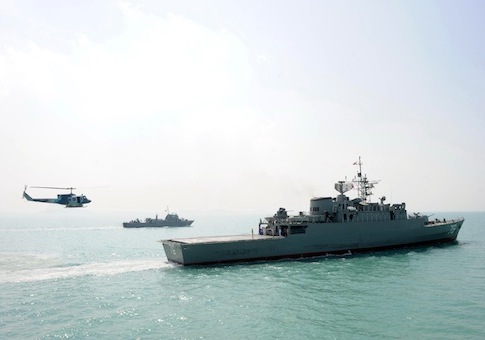A fleet of Iranian warships returned home Thursday following a month long deployment in the Pacific Ocean.
The naval operation shows a surprising amount of range for a navy that in recent months has crept further into international waters.
An Iranian destroyer and helicopter carrier spent most of February in the Pacific Ocean, just months after Supreme Leader Ali Khamenei announced an aggressive expansion of Iran’s naval operations and capabilities.
Some foreign policy observers say the Pacific trek is an Iranian effort to form closer ties to Asian nations, including North Korea.
"Tehran’s dispatch of its navy into the Pacific might be considered a diplomatic shot across the bow," Michael Rubin, a former Pentagon adviser on Iran and Iraq, wrote in a recent analysis of Iran’s increased naval presence.
"Beyond pulling into Zhangjiagang, a port just north of Shanghai, the flotilla is also expected to pay a port call in Sri Lanka on its way home."
The Iranian fleet docked in Southern Iran Thursday following the 72-day mission, according to Iran’s state-run Press TV.
Iran’s arrival in the Pacific "might also shed light on Iranian efforts to develop military ties with Asia," Rubin wrote. "The implication of any Iranian military vessels continuing on to North Korea is alarming," considering the overlapping nuclear aims of both rogue nations.
"While Tehran and Pyongyang cooperate commercially and, according to Western press reports, in the covert exchange of nuclear technology as well, overt military cooperation would suggest confidence and augmentation of ties which might challenge the West," Rubin wrote.
The U.S. military has also "pivoted" toward Asia in recent years.
"Alas," Rubin told the Washington Free Beacon, "it looks like we are not the only ones talking about a pivot to Asia. We can belittle the Iranian navy, but the fact remains that if they can get Sudan and China to provide logistical hubs, we may have something to worry about beyond the Persian Gulf."
North Korea and Iran have emerged as likely allies and trade partners over the years.
Iran has regularly acquired military technology, including ballistic missile capabilities from the North Koreans in violation of United Nations sanctions. Both nations are believed to be exchanging military and nuclear information as they strive to perfect the construction of nuclear weapons.
Iran announced an aggressive naval buildup in February, when it showed off new military hardware during a series of drills.
"Today we have powerful navy, and also very good commercial fleet, and we should strive to accelerate coast line infrastructure developments," Rear Adm. Habibollah Sayyari, commander of Iran’s navy, was quoted as saying in Iran’s state-run media in February. "We can confront any enemy anywhere."
Iran, which views the navy as its primary deterrent to attack, has recently moved ships into the Mediterranean Sea, the Suez Canal, the Red Sea, and elsewhere, according to reports.
An Iranian fleet of warships was sent to "patrol" the Indian Ocean, the Gulf of Aden, Bab-el-Mandeb, the Red Sea, Suez Canal, and the Mediterranean Sea earlier this year.
Additionally, Tehran announced this year that it is building new naval bases as far away as Pakistan.
Sayyari announced in February that an Iranian naval base is being built near the Pakistan port city of Gwadar, a vital economic port near the Arabian Sea and Persian Gulf, Iran’s Mehr News Agency reported at the time.
Sayyari said the base would help Iran "better control movements in the region."
